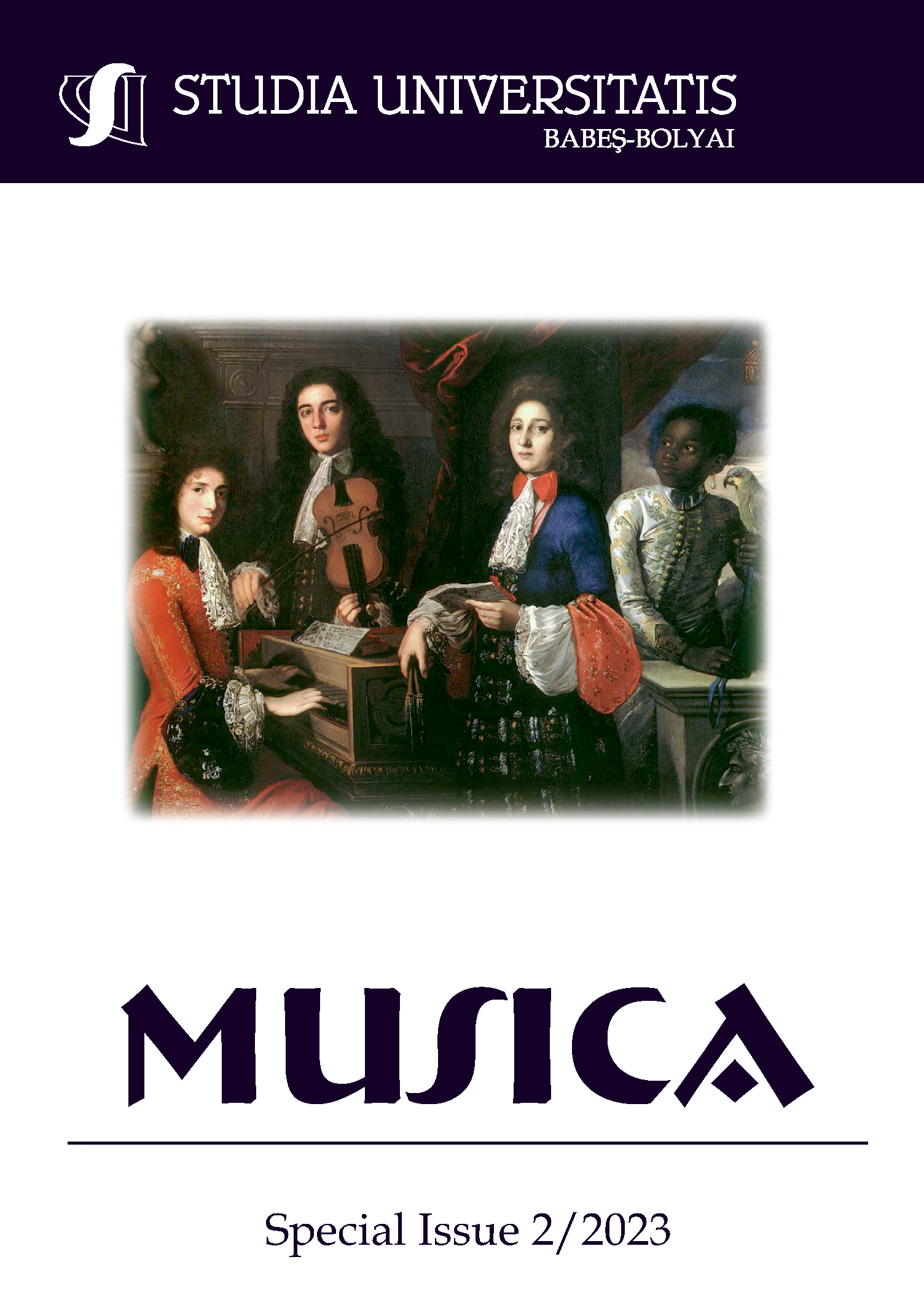THE MUSICAL STYLE OF SÁNDOR VERESS’S „FOUR TRANSYLVANIAN DANCES”. THE SYNTHESIS OF ‘TRADITION’ AND ‘RENEWAL’
DOI:
https://doi.org/10.24193/subbmusica.2023.spiss2.01Keywords:
Sándor Veress, style, compositional techniques, analysis, Four Transylvanian Dances.Abstract
The paper examines the style of Sándor Veress in his first compositional period through the dance suite Four Transylvanian Dances, written for string orchestra. Throughout the musical analysis, the paper points out a few compositional principles and techniques, with which the heritage of classical and folk music can be successfully translated into an innovative and progressive contemporary musical language.
References
Ábrahám, Márta. Bartók és Kodály zenei hatása az 1945 után keletkezett hegedűversenyekre (The Musical Influence of Bartók and Kodály on the Violin Concertos Written After 1945). DLA thesis, Liszt Ferenc Academy of Music, 2013.
Baalbaki, Ioana. “Quattro danze transilvane von Sándor Veress”. In: Tadday, Ulrich (ed.). Musik-Konzepte, 192/193, IV/2021. Edition Text+Kritik, Richard Boorber Verlag, München, 2021, 109-117.
Beckels-Willson, Rachel. “A New Voice, a New 20th Century?”. In: Tempo, 2008/Jan, Vol. 62, No. 246, Cambridge University Press, 2008, 36-41. https://www.jstor.org/stable/40072753 (2021. 11. 25.)
Berlász, Melinda. “Veress Sándor – a népzenekutató” (“Sándor Veress – The Ethnomusicologist”). In: Berlász, Melinda (ed.). Veress Sándor. Tanulmányok (Sándor Veress. Studies.). Zeneműkiadó, Budapest, 1982. 136-148.
Bónis, Ferenc. Üzenetek a XX. századból. Negyvenkét beszélgetés a magyar zenéről (Messages from the 20th century. Forty-two conversations on Hungarian music). Püski kiadó, Budapest, 2002.
Csicsery-Rónai, István (ed.). Veress Sándor. Tanulmányok, cikkek, beszédek (Studies, Articles, Speeches). Occidental Press, Budapest, 2007.
Dalos, Anna. “Veress Sándor elfeledett ifjúsága” (“Forgotten Youth of Sándor Veress”). In: Magyar Zene – zenetudományi folyóirat (Hungarian Music – Journal of Musicology), 59 (2), 2021, 182-203. http://real.mtak.hu/136262/1/Magyar%20Zene_Veress_DalosA.pdf (2022. 06. 09.)
Demény, János. “Veress Sándor – életmű-vázlat” (“Sándor Veress – Biographical Sketch”). In: Berlász, Melinda (ed.). Veress Sándor. Tanulmányok (Sándor Veress. Studies). Zeneműkiadó, Budapest, 1982.
Demény, János. “Sándor Veress”. In: Tempo, No. 88 (Spring 1969), 19-22, Cambridge University Press, 1969. https://www.jstor.org/stable/943372 (2022. 03. 21.)
Fekete, Miklós. “Veress Sándor zeneszerzői indulása és erdélyi kötődése” (“The Compositional Beginnings of Sándor Veress and His Transylvanian Bonding.”). In: Dombi, Józsefné – Maczelka, Noémi (ed.) Kodály 140 – Tanulmánykötet (Kodály 140 – Studies). JATEPress, Szeged, 2023, 94-106.
Gerhard, Anselm – Lanz, Doris (ed.). Sándor Veress. Komponist – Lehrer – Forscher. Bärenreiter Verlag, Kassel, 2008.
Györi, László. “Zwischen Romantik und Atonaliät: Wege der ungarischen Musik im 20. Jahrhundert”. In: Osteuropa, Vol. 61, No. 12 (Dezember 2011), Quo vadis, Hungaria? – Kritik der ungarischen Vernunft, Berliner Wissenschfts-Verlag, 2011, 373-382. http://www.jstor.com/stable/44935917 (2022. 03. 21.)
Retkes, Attila. Kontrasztok. 111 beszélgetés muzsikusokkal (Contrasts. 111 Conversations With Musicians). Wellington, Budapest, 2000.
Retkes, Attila. Zenélő ezredkezdet. Válogatott interjúk 2000-2003 (Musical Commencement of the Millenium. Selected Interviews 2000-2003). Nap Kiadó, Budapest, 2004.
Rumy, Balázs. Veress Sándor klarinétversenye (The Clarinet Concerto Sándor Veress). PhD Thesis. Liszt Ferenc Academy of Music, Budapest, 2018.
Szabó, Judit. Hagyomány és megújulás Veress Sándor vonósnégyeseiben (Tradition and Renewal in the String Quartets of Sándor Veress). PhD Thesis. Liszt Ferenc Academy of Music, 2017.
Szenik, Ilona. Népzenetudományi jegyzet – magyar és román népzene (Notes on Ethnomusicology – Hungarian and Romanian Folk Music). Erdélyi Tankönyvtanács, Kolozsvár, 1998.
Tallián, Tibor. Magyar képek. Fejezetek a magyar zeneélet és zeneszerzés történetéből 1940-1956. (Hungarian Sketches: Chapters from the History of Hungarian Music Culture and Musical Composition, 1940-1956). Balassi Kiadó, Budapest, 2014.
Terényi, Ede. “Veress Sándor alkotóperiódusai. Stíluselemzés” (“Compositional Periods of Sándor Veress. Stylistic Analysis”). In: Berlász Melinda (ed.). Veress Sándor. Tanulmányok (Sándor Veress. Studies). Zeneműkiadó, Budapest, 1982.
Traub, Andreas. Ein verlorenes Werk. Die erste Sinfonie von Sándor Veress. In: Musikforschung, 53. Jahrgang, H.3 (Juli–September 2000), Bärenreiter, 2000, 288-294. Bärenreiter. https://www.jstor.org/stable/41123564 (2022. 03. 21.)
Traub, Andreas. Zum instrumentalen Frühwerk von Sándor Veress. In: Archiv für Musikwissenschaft, 45. Jahrgang, H.3, Franz Steiner Verlag, 1988, 224-247. https://www.jstor.org/stable/930853 (2022. 03. 21.)
Traub, Andreas. Sándor Veress. Lebensweg – Schaffensweg. In: TRAUB, Andreas 1986. Sándor Veress. Festschrift zum 80. Geburtstag (Sándor Veress. Commemorative publication on his 80th birthday), Haselhoff, Berlin, 1986, 22-99.
Downloads
Published
How to Cite
Issue
Section
License
Copyright (c) 2023 Studia Universitatis Babeș-Bolyai Musica

This work is licensed under a Creative Commons Attribution-NonCommercial-NoDerivatives 4.0 International License.






